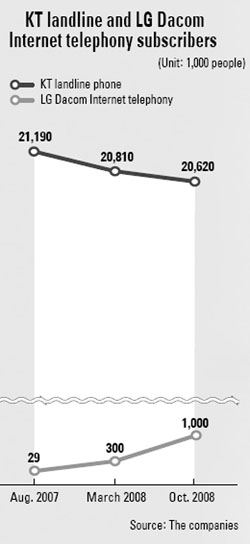Why are more people choosing Internet telephony?

An increasing number of people are moving to Internet telephony because it provides diverse services and is cheaper. [JoongAng Ilbo]
The Korea Communications Commission, which regulates the national telecom and broadcasting industries, gave a nod to number portability on Oct. 31.
This means that people can now switch from regular landline phones to Voice over Internet Protocol (VoIP), or Internet telephony, without changing their phone numbers.
The KCC expects number portability to give the fixed line market a boost. Consumers will save money on telecom bills because Internet telephony charges are far lower than those for conventional landline phones.

Since most spam calls originate from numbers starting with 060 or 080, Internet telephony subscribers are often mistaken as spammers.
This was the main reason people were reluctant to use Internet telephony. But number portability eliminates this worry.
Currently, LG Dacom leads the Internet telephony market with its myLG070 service.
Other operators, including Samsung Networks, KT and SK Broadband, are in hot pursuit trying to attract subscribers.
This means that landline phone operators such as KT and SK Broadband could see sales from landline phone calls decreasing.
In addition, it is still uncertain if the business model is viable. After all, nine out of 10 people in the country already own mobile phones.
After number portability was implemented, 12,567 people applied for Internet telephony services in the four business days starting Nov. 6, providers said.
In other words, an average of 3,141 people per day moved to Internet telephony even though it takes between five and seven days to switch to the service.
Internet telephony allows anyone with a high-speed Web service to make voice calls using their LAN connection.
Its main advantage is that it provides cheaper services compared to landline phones. According to the Korea National Statistical Office, consumers spent 6.4 percent of their monthly income on telecommunication fees last year.
Cheaper telecom services could help with the financial burden during the current economic slowdown.
Let’s compare the cost of landline and Internet telephony services.
Leading landline phone operator KT charges 60,000 won ($45) in start-up fees and a monthly basic rate of 5,200 won.
KT subscribers pay 1,008 won per minute for international calls to the United Kingdom. They also pay for calls to other KT subscribers. Local calls cost 39 won per three-minute block.
However, LG Dacom charges 10,000 won in start-up fees and a 2,000 won monthly basic rate.
International calls to the United Kingdom cost 50 won per minute. Calls to other major foreign countries such as the United States, China and Canada are also charged at 50 won per minute.
Phone calls to other LG Dacom subscribers are free regardless of length of call.
Internet telephony providers offer handsets with diverse functions comparable to mobile phones.
Most Internet telephony handsets work in much the same way as mobile phones.
Users can send text messages, log onto the Internet, store hundreds of telephone numbers and download ringtones.
Other convenient functions include alarm calls, a calculator and a scheduler.
LG Dacom even provides subscribers with a wireless Internet service for free.
As competition among Internet telephony operators heats up, more specialized Internet telephony handsets are appearing on the market.
KT offers an Internet telephony phone which allows subscribers to make video calls as well as voice calls.
Another KT handset has a credit card reader, so subscribers can send money or track financial transactions from their living rooms.
LG Dacom and KT require subscribers to purchase new handsets specifically designed for Internet telephony, called Wi-Fi phones, priced between 70,000 won and 150,000 won.
The handsets are free if subscribers sign on to the service for a minimum length of time.
SK Broadband subscribers do not need to buy a new handset. The company installs an adaptor on existing handsets that converts analog voice signals into digital ones, allowing ordinary telephones to function as Internet phones.
There are more ways consumers can save on telecom fees.
Subscribing to dual-play or triple-play services, which bundle two or three different telecom services together such as broadband access, TV and telephony, will allow consumers to save as telecom companies tend to give bigger discounts on bundled services.
Despite the many advantages, however, there are still a few things to keep in mind when choosing an Internet telephony service.
If you subscribe to Internet telephony but retain your old telephone number, you will still need to pay for phone calls to subscribers on the same network.
KT, once a state-run organization but privatized in 2002, still manages the nation’s key telecommunication infrastructure.
Internet telephony operators have to pay 3.19 won per minute in fees to use KT’s platform in order to identify whether non-070 numbers are Internet telephony calls.
“The 070 numbers are instantly recognizable as Internet telephony numbers, but for other numbers, we need to access KT’s platform to identify whether they are Internet telephony or not,” said Kwon Myung-jin, an LG Dacom official.
There are other considerations, too.
Landline telephones automatically track down a caller’s location. However, this is impossible with Internet telephony.
This is why Internet telephony subscribers must notify operators of their new address whenever they move.
In the worst case scenario, it is possible that Internet telephony could be used for voice phishing because Internet phone calls are hard to track down.
Internet telephony also does not work during a power cut. In contrast, landline telephones receive electricity over the telephone line during power failures.
Internet telephony might also be less reliable in areas with poor broadband infrastructure.
Although 95 percent of households have access to high-speed Internet services, some remote and mountainous regions have weak Internet connections due to weather conditions. Despite these drawbacks, 1.6 million Koreans have already switched from traditional fixed-line phones to Internet telephony since late August.
According to the Korean branch of IDC, a U.S.-based technology research firm, the local Internet telephony market is expected to reach 1.15 trillion won in 2011.
By operators, LG Dacom accounts for 58.1 percent of the market, Samsung Networks for 18.1 percent, KT for 14.4 percent and SK Broadband for 0.6 percent as of late August.
Meanwhile, number portability has been implemented in developed countries since the late 1990s.
The United Kingdom introduced number portability in 1999, Australia in 2001 and the United States in 2003.
But number portability failed to gain popularity in those countries because it usually takes up to one month to switch telephone or mobile phone operators.
In Korea, number portability was first introduced for the mobile phone industry in January 2004.
The aim of the scheme was to give consumers the freedom to choose the best service while retaining their existing mobile phone numbers.
Ever since mobile number portability was introduced, more than 30 million people have switched mobile phone operators.
In order to retain or steal subscribers, mobile phone operators used to provide free phones, which led them to incur astronomical marketing costs.
That’s why the KCC decided in the first half of this year to adopt a compulsory subscription period. This provides discounts to mobile phone users in return for a committed subscription period.
Under the compulsory subscription plan, people are required to use the same mobile phone operator for up to three years.
The new system has allowed mobile phone operators to cut down on marketing costs in the third quarter of this year, according to their earnings reports.
By Sung So-young Staff Reporter/ Choi Ik-jae JoongAng Ilbo [so@joongang.co.kr]










with the Korea JoongAng Daily
To write comments, please log in to one of the accounts.
Standards Board Policy (0/250자)